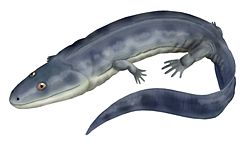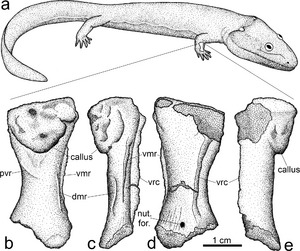Ossinodus facts for kids
Quick facts for kids Ossinodus |
|
|---|---|
 |
|
| Scientific classification | |
| Kingdom: | |
| Phylum: | |
| Superclass: | |
| Family: |
?Whatcheeriidae
|
| Genus: |
Ossinodus
Warren and Turner, 2004
|
| Species | |
|
|
Ossinodus is an extinct animal that was an early type of tetrapod. Tetrapods are creatures with four limbs, like amphibians, reptiles, birds, and mammals. Fossils of Ossinodus have been found in Queensland, Australia. These fossils date back to the Early Carboniferous period, about 333 million years ago.
Scientists first thought Ossinodus belonged to a group called Whatcheeriidae. However, new studies of its skull suggest it might be an even older, more basic type of tetrapod than the Whatcheeriidae.
Interestingly, a broken arm bone (called a radius) found from Ossinodus is the oldest known example of a bone injury in a tetrapod. This shows that these ancient animals could heal their broken bones!
Contents
Discovering Ossinodus
Ossinodus is one of the first large tetrapods found from a time called Romer’s Gap. This was a period in Earth's history (about 360 to 345 million years ago) when very few tetrapod fossils have been discovered. It's like a missing chapter in the fossil record!
How it was found
In 1996, scientists started looking at some bone pieces. At first, they thought the bones might belong to three different types of ancient animals. But later, all the Ossinodus bones were found together at one site. These bones came in many sizes, from small to large. This suggested they were all from the same group, O. pueri, and included both young and adult animals.
The fossils were found in the Drummond Basin of Queensland, Australia. This area was once a shallow water environment, like a large river or lake, with lots of mud, clay, and other sediments.
Why the discovery was important
The excavation of Ossinodus fossils began in 1996 and finished in 2004. Scientists found many separate bones and half a skull. These discoveries were very important because they suggested that the first land-dwelling tetrapods might have lived in Gondwana (an ancient supercontinent that included Australia). Before this, many thought early tetrapods were only small creatures from Europe.
What Ossinodus Looked Like
Ossinodus was a fairly large animal, estimated to be about 1 to 2 meters (3 to 6.5 feet) long. This is similar in size to a modern Chinese giant salamander. Based on its teeth and where it lived, scientists believe Ossinodus was a piscivore, meaning it mostly ate fish.
Its Skull
The skull of Ossinodus was wide and had a rough, bumpy surface. It had deep pits and ridges all over, especially on the top of its head and jaw. These pits were smaller on its snout and larger on the top of its skull.
Ossinodus had small eyes located towards the front of its head. Its nostrils were placed quite low on the sides of its skull. It also had an internal sensory canal, which is a feature that suggests it was moving away from a fully aquatic lifestyle.
Its Teeth
Ossinodus had about 34 teeth along its upper jaw, plus an inner row of teeth on the roof of its mouth. The largest teeth were its maxillary fangs. Its teeth were shaped like spearheads and had grooves. Inside, the teeth had complex, irregular folds. This type of tooth structure is called polyplocodont.
Bones of the Body
Most of the bones in Ossinodus's body (other than the skull) were smaller than its skull. Some of its shoulder and chest bones looked similar to those of Whatcheeriidae and Pederpes, which are its close relatives. Like its skull, some of these body bones also had deep pits.
Its spine had upright neural spines, which are bony projections on the vertebrae. Its leg bones, like the femur (thigh bone) and tibia (shin bone), were strong. The humerus (upper arm bone) was also covered in many pits.
The most famous Ossinodus bone is a broken radius (a forearm bone). This bone had prominent ridges, similar to other early tetrapods. Like some other ancient tetrapods, its radius was shorter and less narrow. The pits and bumps on its bones might have been places where muscles attached.
How Ossinodus Lived
Bone Healing and Lifestyle
The fractured right radius bone of an Ossinodus specimen tells us a lot about how these early tetrapods lived. Scientists studied this broken bone and found that the amount of force needed to cause such damage would likely come from a fall from a certain height. This suggests that Ossinodus must have spent a good amount of time on land, not just in water.
The bone also showed signs of healing, with new bone growth around the break. This is one of the earliest examples of bone healing found in ancient tetrapods! It shows that these creatures could recover from serious injuries.
Its Habitat
Early tetrapods were thought to spend most of their time in water, often just poking their heads out. However, the fractured radius of Ossinodus suggests otherwise. The way the bone healed and grew indicates it was constantly under stress from supporting a heavy weight. This would only happen if the animal spent a lot of time on land.
While some evidence from its hind limbs suggests it could swim, Ossinodus might have been a key species in the transition from water to land. Smaller, younger Ossinodus might have spent more time in water, while older ones spent more time on land. The internal sensory canal in its skull also points to tetrapods moving away from relying only on water-based senses. These findings help us understand how animals moved from living in water to living on land.
Where Ossinodus Lived
The Middle Paddock site in Australia, where the Ossinodus fossils were found, was part of a "deltaic system." This means it was an area where a river met a larger body of water, creating flood plains and layers of silt, sand, and limestone.
Scientists also found fossils of other aquatic animals at the site, such as lungfish and sharks. This shows that Ossinodus lived alongside these water-dwelling species, confirming it was part of an environment that included both land and water.
Family Tree
The closest relatives of Ossinodus are Whatcheeriidae and Pederpes. Scientists group them together because they share similar features in their body bones. However, Ossinodus is different because its skull bones are much larger compared to its limb bones. An adult Ossinodus was also generally bigger than a full-grown Whatcheeriidae or Pederpes.
The skull of Ossinodus was wider, shallower, and longer than the skulls of Whatcheeriidae. Also, the bumpy patterns on the skull and body bones of Ossinodus were more noticeable and covered more areas than on its relatives.
Scientists generally agree that Ossinodus, Whatcheeriidae, and Pederpes are closely related. There is some discussion about whether Ossinodus is a direct sister group to the other two, or if it's an even older ancestor. Based on its features, Ossinodus seems to have more primitive traits, suggesting it might be older than Whatcheeriidae and Pederpes.
See also
 In Spanish: Ossinodus para niños
In Spanish: Ossinodus para niños


